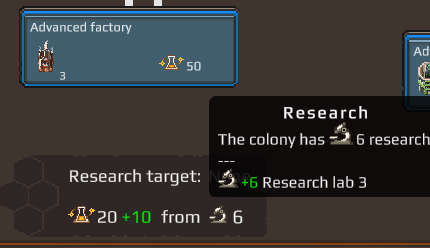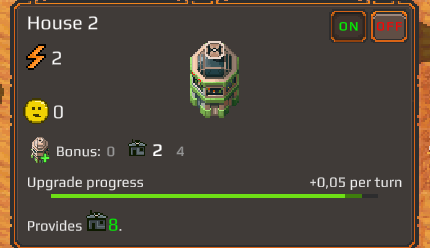What to expect in Farlanders comparing to Prologue
Greetings,
I want to talk with you in a bit more detail about what is planned for the main Farlanders game in comparison to the Farlanders: Prologue. Usually, when designing a game, I’m not adding mechanics just for the sake of it. Instead, I’m trying to create an emotion or the feel that the player will get. So in this article, I will not simply describe mechanics, I’ll try to explain why I’m adding them and what is their purpose.
📖Story
Writing a story for the Prologue was one of my first-ever writing attempts. With that said, it’s not perfect and I can’t say that I’m fully satisfied with the result. However, I learned a lot from the experience. The main thing is that there should be less text and dialogues. After all, Farlanders is less about narrative and more about the strategy of building colonies.
The purpose of any story, or narrative is to give you space for a fantasy to imagine something beyond a group of 32×32 pixel sprites . And, if done properly, it could be better achieved with illustration and cutscenes rather than with text.
In the main game, the campaign will consist of multiple scenarios. You will have the continuation of a story with Nicole, scenarios with brand new characters, and even a secret scenario with another character from the Prologue.
🏗 Colony Specialization
To add more depth to the game, I want to make it possible to build a successful colony in different ways. For example, if you have a lot of open space and water – focus on growing crops, and then purchase resources that you are missing. For this to work, we need a trading system.
And to make specialization even more clear I’m adding a technology tree. Through this tree, you can unlock new buildings and upgrades. For example, if your current focus is to make your people happy, you can research public spaces or unlock an upgrade for a factory, which reduces the factory noise.

One thing that was unclear to me for some time was how to create a monetary income (for mechanics like trade to work). Because any Martian colony, at least in the early stage, is unprofitable. I found a solution in another mechanic that I was considering for a while – making Mars green! To justify an expensive and difficult process of growing plants on Mars, you will receive a monetary subsidy from the government, which will make your colony’s main income.
🏘 Colony Aesthetic
It is important to be able to enjoy your creations in any building game, which is why we are working on visual improvements. There will be multiple visual versions of most of the buildings (not counting Kickstarter exclusive skins), and we will be adding visual effects to make the game feel more alive.
But, more importantly, the beauty of your colony depends on how you build it. And we, as developers, can affect it, with game design! In the Prologue, most of the buildings are immediately upgraded when there is a building of the same type nearby. This system will be expanded in the main game. The building will slowly develop – depending on the environment – until it reaches a certain threshold to level up.

For example, if we take a living house, it will receive a growing bonus from other houses (as it does in the Prologue) but also from parks, restaurants, greens, etc. But there may be negative effects from certain buildings. After all, who wants to live in a house near a mineral stockpile? This way we can stimulate players to build distinctive residential or industrial districts.
🎮Play the Game Your Own Way
I’m personally quite a hardcore player, so I appreciate a challenge, and it’s fine for me to lose and start over (if the game has random levels). But I understand that this kind of playstyle is not for everyone. Therefore, in the main game, you’ll be able to:
- Save/load your colony at any moment, unless ‘Ironman Mode’ is selected
- Pick your difficulty for campaign missions
- Play in customizable sandbox mode, where you can customize the map and even remove some of the game mechanics
- Compete with other players for the best score through the Daily Challenge
🔒Exploration & Underground Expansion
The following mechanics are locked under $15k and $20k stretch goals, but I still want to talk about them because I’m excited to implement them! Those mechanics are tied together and are intended to give you:
- A sense of awe when you discover a rare resource, or artifact underground
- 3-dimensional planning, so that you can finally build an underground tunnel to connect your farms to the base
With the exploration system on, the map is covered by a fog of war under which you can see a landscape, but can’t see details such as resources or artifacts. To clear the fog of war, an area should be accessible by a rover, which means that the rover should be able to travel from the base to the area via flat ground (no mountains, walls, or canyons).
Underground expansion means that you can explode some of the canyons and gain access to underground caves which are randomly generated. From there, you can terraform, explore, or use the space as a playground for colony expansion. Although, underground layers work differently than those on the surface. Aside from a lack of sunlight, you’ll notice that:
- Terraforming is a bit different. There is no wasteland, but there are impenetrable rocks that you can’t terraform
- There are some limitations to the building. For example, you’ll have to research a special underground house and, as you go deeper, it will be harder and harder to build
🖋Conclusion
I hope you had a good read! You can continue to support our Kickstarter campaign, follow me on Twitter, or play the Prologue and leave a review. All of this will help the game to grow. Except for maybe the Twitter part, which only grows my ego.
Get Farlanders: Prologue
Farlanders: Prologue
Mars colony city-builder with terraforming
| Status | Released |
| Author | Andriy Bychkovskyi |
| Genre | Strategy, Survival |
| Tags | 2D, City Builder, Management, Pixel Art, Procedural Generation, Turn-based |
| Languages | English |
| Accessibility | One button |

Leave a comment
Log in with itch.io to leave a comment.